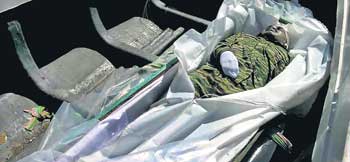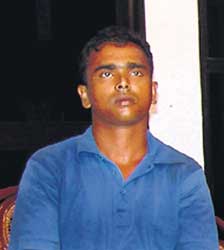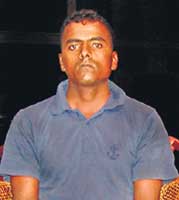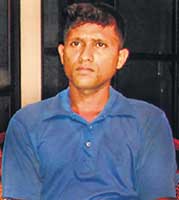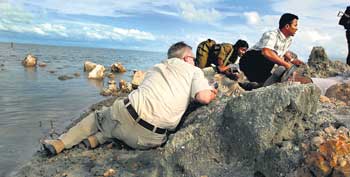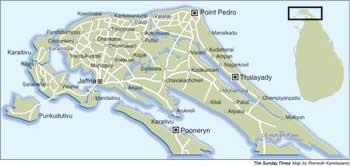
| Sea battles for A9
The message on Thursday reached Northern Naval Area Headquarters (NNAHQ) almost simultaneously. It was around 4.30 p.m. A naval patrol at location "Charlie" reported that a flotilla of Sea Tiger boats was headed northwards. That was from their base in Thalayady (south of Nagerkovil near Muhamalai). At the same time, the naval detachment at Point Pedro saw blips on their radar. The flotilla was in the seas, some five nautical miles from the shores of Point Pedro. Those at the Operations Room at NNAHQ were not unduly alarmed. In fact, only days earlier they sent out their latest warning to naval establishments in the Jaffna peninsula. Possible surprise attacks by Sea Tigers prompted them to enhance security measures. Additional precautions were taken along the coast and in the outlying islands. The scenes at the NNAHQ after the news arrived resembled a war movie. Some officers and men were rushing to board ten Fast Attack Craft (FACs). Others were already on board and readying the weapons systems or taking in loads of assorted ammunition. Some officers were hurriedly giving their men a last minute briefing. They set sail to form a barrier to face the enemy flotilla. They were soon in battle.
It came as the naval craft were advancing towards 15 Sea Tiger boats. They were under intense fire. An explosive laden Sea Tiger boat manned by suicide cadres rammed Dvora (P 416). It was engulfed in a ball of fire, disintegrated into pieces and sank. There was nothing left of it. Later, Dvora (461) was hit. It was on fire. NNAHQ sought help. Air Force Kfir jets and Mi-24 helicopter gun-ships arrived. They engaged the Sea Tiger boats. Their pilots had a difficult task since the targets were moving. The Eastern Naval Area Headquarters in Trincomalee sent seven Dvora Fast Attack Craft. They joined in the fighting. As dusk began to envelope the area, survivors said the battle resembled a massive fireworks display at sea. It was only when it ended three hours later that the details of the drama began to unfold. There were of course different official versions of the incident. They contradicted each other. All of them, as has been the practice in the recent past, spoke of exceedingly high enemy losses both in terms of men and material or gave accounts that were not even remotely related to the sea battle. Do people believe them? Dissemination of disinformation is not unusual during a war. They are considered part of an exercise, among other matters, to boost public morale. But unrealistic and lopsided claims, sometimes to cover up shortcomings of those responsible for lapses and at other times to create an aura of unprecedented successes, have far reaching consequences. In this enlightened era, they raise serious questions of credibility for the Government and cast doubts in the minds of the discerning public. Those who are unsuspecting tend to believe in some of the yarns and are lulled into a high degree of complacency. That, sad enough can deny the Security Forces the higher degree of co-operation and support they expect from the public. This is when the veracity of the claims made is proven to be far from the truth. Thursday's incident is a classic case of this syndrome like the October 11 Muhamalai debacle. One simple example to illustrate the point is the claim that 22 Sea Tiger boats were destroyed in Thursday's sea battle. The Sunday Times has confirmed with highly placed sources in the Navy that only 15 boats were involved in the attack. The question therefore is whether those responsible for such spin truly believe the public would gobble up what they say. Why insult their intelligence then? Even the Secretary to the President, the genial Lalith Weeratunga, who visited the NNAHQ at Kankesanthurai on Friday, underscored this grim reality. During a short speech, he highlighted the need for officers and men in the Navy to remain in a high state of alert. He cautioned them that there was no room for complacency. Mr. Weeratunga arrived there on a previously scheduled visit to see how food supplies to the peninsula were being handled. He was accompanied by the Commander of the Navy, Vice Admiral Wasantha Karannagoda. By Friday morning, the trail left behind by the encounter in the seas off Point Pedro became clearer. The Navy had lost two Dvora Fast Attack Craft, P 416 and P 461. On Friday, Navy divers recovered the bodies of four sailors (from P 461) but could not locate even the wreckage of the first Dvora (P 416) that was destroyed. Divers were to resume their search yesterday.
When the second Dvora (P 461) was burning, Sea Tiger cadres boarded the naval vessel. They took four sailors into custody and removed the weapons on board. They were Leading Seaman Kamal Hemantha Kumarasiri (26), Samantha Kumara Hewage (28), Indika Prashantha Pitiyakumbura and Anil Priyanka Madadeniya (21).
The main armament of the Dvora, the 23 mm Canon, Heckler & Koch AGL (Automatic Grenade Launchers), Fifty Calibre (Point Five Zero) Guns and Light Machine Guns were seized. A large stock of 23 mm Canon shells was also seized. Pictures of the captured sailors together with the weapons seized were displayed in the pro-LTTE website Tamilnet. This was how Sri Lankans and the outside world first knew of the hostages and the seizure of weapons. Official accounts claimed "many Sea Tiger cadres were killed." LTTE's "Military Spokesman" Irasiah Ilanthiriyan was quoted in the Tamilnet as saying five Sea Tiger cadres died. Independent verification of guerrilla casualties is not possible. On Friday the Navy was trying to ascertain how many were on board Dvora P-461, whether it was 16 or 18 together with the Officer-in-charge and his deputy.
Four bodies of crew members were recovered and four more have been taken hostage by the LTTE. In respect of Dvora P-416 which was destroyed, there were 17 Navy personnel on board. Five of them were rescued. Twelve have been classified as Missing in Action and are feared dead. On Friday morning, alert Navy personnel had a different encounter in Trincomalee. At dawn, a Navy patrol in the seas near Fort Frederick, at Back Bay, observed what appeared to be a cluster of fishing boats. It was before 6 a.m. when fishing is allowed in the seas off Trincomalee. The patrol closed in cautiously after firing warning shots into the air. A battle ensued. At least one Sea Tiger boat, said to be explosive laden and with suicide cadres, was destroyed. Navy personnel observed from a distance that one of the boats carried a coffin. They were not sure whether it held a dead cadre or an improvised explosive device. They could not get closer for fear of explosions. And soon, the other boats fled from the area and the Navy gave chase. The answer came after the Sea Tiger boats were apprehended off the coast of Sampaltivu. The coffin held the body of Arivu, the LTTE deputy military wing leader for Trincomalee district. He was number two to "Colonel" Sornam. A routine Army patrol at a location north of Batticaloa had observed Arivu and a group laying an ambush for them. They hit back killing Arivu. His body had been brought to Trincomalee south for embalming and was headed for Mullaitivu where the LTTE leadership was to accord him "funeral honours." If the LTTE took four sailors as hostage on Thursday, it was now the Navy's turn. On Friday at Sampaltivu, Navy sources in Trincomalee said, they arrested Karvannan together with two of his accomplices. He was one of those responsible for Sea Tiger boat movements from Trincomalee to Mullaitivu and vice versa. Arivu's body which was retained in the morgue at Trincomalee hospital was later handed over to the International Committee of the Red Cross (ICRC). They in turn handed it over to the LTTE yesterday. The Sea Tiger attack on the Navy off Point Pedro on Thursday, quite clearly in contravention of the Ceasefire Agreement of February 2002, is significant in many respects. The most important is the clear message that the LTTE would continue to mount pressure on the Navy to restrict their use of the north-eastern seas. The move is to hinder Government's efforts to transport food, fuel, medicine and other essential items by sea and force it to re-open the A-9 highway from the Muhamalai end. In the light of this, intelligence sources do not rule out more battles at sea. The Government continues to remain steadfast that its decision to re-open the A-9 highway for contiguous access from the Wanni to Jaffna peninsula will not be changed. This is the issue on which peace talks in Geneva on October 28 and 29 collapsed. Sri Lanka delegation leader, Nimal Siripala de Silva declared that the Government wanted to watch the LTTE for "two to three" weeks before taking a decision. But an increase in hostilities between the Security Forces and Tiger guerrillas has distanced the two sides from talking peace to waging more war. The Sunday Times learnt that during the collapsed Geneva talks the leader of the LTTE delegation S.P. Thamilselvan made a proposal to extend the two-day talks in Geneva. He had told Norwegian facilitators that their delegation was willing to stay for two or three more days if the Sri Lanka Government delegation was willing to extend the talks to arrive at a decision on the opening of the A-9 highway. The Norwegian facilitators had in turn conveyed it to the Government delegation. However, Government members had said they could not do so due to prior commitments in Colombo.
It is in this backdrop that the Sri Lanka Monitoring Mission (SLMM) was examining the practicality of an alternate supply route to Jaffna suggested by the Government. The proposal was first placed before Erik Solheim, Norway's Minister for International Development. The Head of the SLMM, retired Norwegian Major General Lars Johan Solvberg, was making an on-the-spot study of this proposal in the Wanni. Whilst in Pooneryn, a one time jetty divided from Jaffna town by the lagoon there, together with LTTE's Pulithevam (S. Prabagaran), narrowly escaped Army artillery fire that fell on the area. The incident angered the Norwegian Government.
Sri Lanka's Ambassador to Norway, Ahamed Jawad, was summoned to
the Foreign Ministry in Oslo, to be handed a strong protest over
the incident. During a conference summoned to brief envoys of the
Donor Co-chairs (United States, European Union, Japan and Norway)at
the Foreign Ministry on Thursday the issue was raised by Norway's
Ambassador to Sri Lanka Hans Brattskar. A reply came from Army Commander
Lt. Gen. Sarath Fonseka. He said the Army was unaware of the presence
of the SLMM head in Pooneryn. The Norwegian envoy did not pursue
the matter further at the conference. At the same conference, the subject of the alternative route came up. The Secretary General of the SCOPP, one time UN diplomat Palitha Kohona, said such a route could only be opened with the consent of the two sides i.e. the Government and the LTTE. The latter has already rejected the alternative route via Pooneryn to Jaffna. That brings the issue back to the re-opening of the A-9 highway, the Entry-Exit point at Muhamalai. This assumes added significance in the light of the November 27 "Maveerar (or Great) Heroes Day address by LTTE leader, Velupillai Prabhakaran. With only two weeks or 14 days to go for the event, ground realities have changed considerably. It is continuing to change. Until October 11, when it was widely perceived that the LTTE has almost been defeated militarily, questions were raised over what Mr. Prabhakaran would say. That again was in the light of the ultimatum he issued on November 27 last year. In that he warned that if the Government "rejects our urgent appeal, we will, next year, in solidarity with our people intensify our struggle for self-determination, our struggle for national liberation to establish self-government in our homeland." That is if the Government of President Mahinda Rajapaksa did not come forward soon with a "reasonable political framework" that will satisfy the political aspirations of the Tamil people.
On October 11, the Army's debacle in Muhamalai was the beginning of a major change in the scenario. Many other factors that would sure form key elements in Mr. Prabhakaran's address were offered by the Government, either through its inaction, inability or both. That includes the growing humanitarian crisis in the north where food, fuel and essential items are still in short supply. It is no secret that the current crisis is unprecedented with civilians in the North being forced into near levels of starvation. Hard on the heels of this followed the incident in Kathiraveli, north of Vakarai where men, women and children, who were in a school complex housing internally displaced persons, were killed and others injured by Army artillery and Multi Barrel Rocket fire. The incident that forced the Government to express regret drew the ire of the international community and generated grossly adverse worldwide publicity for the country. On Thursday the United States urged the Government to conduct an "immediate, independent investigation into the November 8 incidents and bring the responsible parties to justice." The US said it would exhort the Sri Lanka Government to adopt corrective measures to prevent civilian casualties "that also take into account instances where civilians may be used as 'human shields' in the future." A statement issued in Washington by State Department spokesman said the US is also "disturbed that the Head of the Sri Lanka Monitoring Mission and his delegation came under fire in Pooneryn in the north of Sri Lanka on the same day." Hard on the heels of this came another incident in Colombo. On Friday, Tamil National Alliance parliamentarian Nadarajah Raviraj, was shot dead in broad day light at Narahenpita. Once again, the incident was to draw more adverse worldwide publicity about the deteriorating law and order situation and the worsening humanitarian crisis in Sri Lanka. Mr. Raviraj was a fearless Tamil politician who courageously espoused the cause of the people he represented. That was both in and out of Parliament. Details of the attack on civilians in Vakarai and the assassination of Mr. Raviraj appear elsewhere in The Sunday Times. In a bid to underscore the Government's serious concern, President Mahinda Rajapaksa declared that help from Britain's Scotland Yard would be sought to assist in investigations. The last occasion when such help was obtained was during the late President Ranasinghe Premadasa's tenure. It came after the assassination of Lalith Athulathmudali on April 23, 1993. Not even the assassination of former Foreign Minister Lakshman Kadirgamar on August 12 last year led to seeking Scotland Yard assistance. A Government source explained, "In that killing, we know who the culprits are. It was the LTTE. In this shooting, the assailants have not been identified. We want to know who is behind it and what the motives are." These incidents have not merely given the LTTE
leader a few issues to highlight in his speech. More importantly,
from his perception, he can claim, much against many wishes in the
south, a "justification" for retaliatory military action.
This is why heightened military preparations have gone into place
and Security Forces are in a high state of alert. Can the resultant
uncertainty continue for ever? |
||||||||||||
| || Front
Page | News
| Editorial
| Columns
| Sports
| Plus
| Financial
Times | International
| Mirror
| TV
Times | Funday
Times | ST-1
|| |
| |
Copyright
2006 Wijeya
Newspapers Ltd.Colombo. Sri Lanka. |
